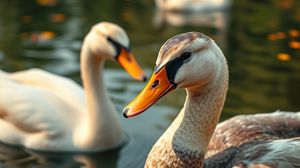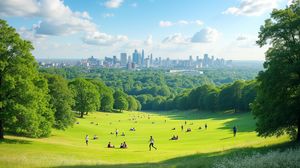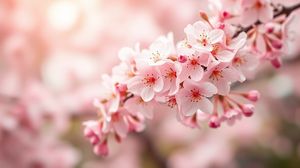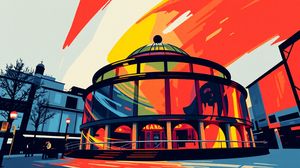
Hampstead Ponds are a trio of freshwater swimming ponds located on the Heath within Hampstead Heath, offering a unique escape into nature in the city of London. They are one of the few places in London where you can experience open-air freshwater swimming, with separate ponds designated for men, women, and mixed swimming. The ponds are a cherished part of the local heritage, appreciated for their serene setting and natural beauty.
The history of Hampstead Ponds dates back to the 17th century when they were created as part of London's water supply system. Over time, these reservoirs evolved into recreational swimming ponds, a transition solidified in the Victorian era as public recreation in natural settings gained popularity. Today, they're maintained by the City of London Corporation, preserving their historical legacy while serving as a contemporary recreational venue.
An interesting fact about Hampstead Ponds is that they attract a diverse range of wildlife. Over 180 bird species have been recorded on the Heath, and the ponds themselves are a haven for various aquatic creatures, making it a fantastic spot for nature enthusiasts as well as swimmers. The area around the ponds offers beautiful walking paths and scenic views, providing a peaceful retreat from the bustling city.
Swimming in the ponds is permitted all year round, offering a unique experience in London's outdoors. While summer is the peak season for swimmers, a number of hardy locals take a chilly plunge even in the colder months, embodying the spirit of the place. It's a vivid reminder of the British penchant for open water swimming and the communal culture thriving at the Heath.
A quirky aspect of the Hampstead Ponds is their connection to local culture and literature. Over the years, many famous authors and artists, including the likes of John Keats and Charles Dickens, have frequented the area, drawn by its tranquillity and inspiration. Their legacy adds a layer of cultural intrigue to the already fascinating site.
Despite being in the heart of London, Hampstead Ponds offer a unique and somewhat surreal experience of swimming amidst greenery, as city noise fades into the background. The ponds have become emblematic of the Heath itself, symbolizing a balance between natural and urban life that makes London a unique place to explore.

Making the Most of Your Visit:
If you're planning to take a dip, remember that the Men's, Women's, and Mixed Ponds have different entry points, so follow the signs and maps accordingly to find your chosen spot smoothly.
Pack a picnic or snacks, as there are no cafes or food stalls right by the ponds. There's plenty of grassy space to enjoy a picnic while soaking in the beautiful natural surroundings.
During colder months, consider bringing a hot drink in a thermos to warm up post-swim. Many of the regulars swear by a good cup of tea or coffee to fend off the chill.
Interested in birdwatching? Bring a pair of binoculars to make the most of your visit. The Heath is home to a variety of bird species, and you'll often spot them bustling around the ponds.
Arrive early if you want to secure a good spot, especially on sunny days. The ponds can get busy, and early mornings offer the most tranquil experience.

Visiting Times & Costs:
Hampstead Ponds are open to the public throughout the year, offering a unique natural swimming experience in London. However, it is important to take note of seasonal opening hours for swimming:
- Summer Season (May - September): The ponds generally open early in the morning and close in the evening, allowing ample daylight swimming hours.
- Winter Season (October - April): Swimming is still available but with reduced hours due to shorter daylight. It's advisable to check specific opening times before planning your visit as they can vary with the season.
Entrance Fees: The ponds have a small entry fee for swimming, which helps maintain the facilities. The exact cost can vary, so check locally for the most current details.
Accessibility Issues: While the ponds are a natural outdoor setting with some basic facilities, accessibility can be a challenge. Pathways may be uneven, and steps are present in some areas, making access difficult for those with mobility impairments. It is recommended to review accessibility options in advance to ensure a comfortable visit.

Address & Map:

Nearby:























